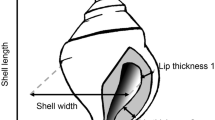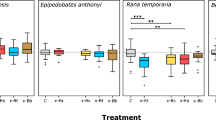Abstract
The big-handed brachyuran crab Heterozius rotundifronsextends the time spent in its anti-predator posture, limb extended posture, if exposed to chemical cues from crushed conspecifics. In this study, we tested whether crabs also respond to chemical cues from crushed heterospecific crabs, and if so, whether phylogenetic relations or ecological overlap is more important in influencing the duration of the anti-predator posture. Chemical cues from two other brachyuran crabs (Cyclograpsus lavauxi and Hemigrapsus sexdentatus), which do not overlap directly in ecological distribution with H. rotundifrons, elicited a duration of the anti-predator posture that was indistinguishable from that produced by conspecific chemical cues. In contrast, chemical cues from two anomuran crabs (Petrolisthes elongatus and Pagurus novizealandiae) that overlap in ecological distribution with H. rotundifrons, elicited durations of the antipredator posture that were significantly shorter than those of either conspecifics or more closely related crab species. Thus, phylogenetic relationship seems to be more important than ecological overlap in influencing anti-predator behavior in H. rotundifrons.
Similar content being viewed by others
References
BROWN, G. E. and CHIVERS, D. P. In Press. Learning as an adaptive response to predation. In P. Barbosa (ed). Ecology of Predator-Prey Interactions, Oxford Univ. Press.
FIELD, L. H. 1990. Aberrant defense display of the big-handed crab, Heterozius rotundifrons (Brachyura: Belliidae). New Zealand J. Marine and Freshwater Res. 24:211–220.
GHERARDI, F., ACQUISTAPACE, P., HAZLETT B. A., and WHISSON, G. 2002. Behavioural responses to danger odours in indigenous and non-indigenous crayfish species: a case study from Western Australia. Marine and Freshwater Res. 53:93–98.
HAZLETT, B. A. 2000. Information use by an invading species: do invaders respond more to alarm odors than native species? Biol. Invasions 2:289–294.
HAZLETT, B. A., BURBA, A., GHERARDI, F., and ACQUISTAPACE, P. 2003. Invasive species of crayfish use a broader range of predation-risk cues than native species. Biol. Invasions 5:223–228.
HAZLETT, B. A. 1996. Comparative study of hermit crab responses to shell-related chemical cues. J. Chem. Ecol. 22:2317–2329.
HAZLETT, B. A. and MCLAY, C. 2000. Contingencies in the behaviour of the crab Heterozius rotundifrons. Anim. Behav. 59:965–974.
HAZLETT, B. A. and MCLAY, C. In Press. Responses to predation risk: Alternative strategies in the crabHeterozius rotundifrons. Anim. Behav.
MATHIS, A. and SMITH, R. J. F. 1993. Chemical alarm signals increase the survival time of fathead minnows (Pimephales promelas) during encounters with northern pike (Esox lucius). Behav. Ecol. 4:260–265.
MCLAY, C. 1988. Brachyura and crab-like Anomura of New Zealand. Leigh Lab. Bull. 22:1–463.
MIRZA, R. S. and CHIVERS, D. P. 2001. Are alarm signals conserved within salmonid fishes: J. Chem. Ecol. 27:1641–1655.
MIRZA, R. S. and CHIVERS, D. P. 2003. Influence of body size on the responses of fathead minnows, Pimephales promelas, to damselfly alarm cues. Ethology 109:691–699.
RITTSCHOF, D., TSAI, D. W., MASSEY, P. G., BLANCO, L., KUEBER, G. L., Jr., and HAAS, R. J. 1992. Chemical mediation of behavior in hermit crabs: alarm and aggregation cues. J. Chem. Ecol. 18:959–984.
SMITH, R. J. F. 1992. Alarm signals in fishes. Rev. Fish Biol. Fish. 2:33–63.
STENZLER, D. and ATEMA, J. 1977. Alarm responses of the marine mud snail, Nassarius obsoletus: specificity and behavioral priority. J. Chem. Ecol. 3:159–171.
THACKER, R. W. 1994. Volatile shell-investigation cues of land hermit crabs: Effect of shell fit, detection of cues from other hermit crab species, and cue isolation. J. Chem. Ecol. 20: 1457–1482.
WISENDEN, B. D. 2000. Olfactory assessment of predation risk in the aquatic environment. Phil. Trans. R. Soc. Land. B 355:1205–1208.
WISENDEN, B. D., CLINE, A., and SPARKES, T. C. 1999. Survival benefits to antipredator behaviour in the amphipod Gammams minus (Crustacea: Amphipoda) in response to injury-released chemical cues from conspecific and heterospecifics. Ethology 105:407–414.
Author information
Authors and Affiliations
Corresponding author
Rights and permissions
About this article
Cite this article
Hazlett, B.A., McLay, C. Responses of the Crab Heterozius rotundifronsto Heterospecific Chemical Alarm Cues: Phylogeny vs. Ecological Overlap. J Chem Ecol 31, 671–677 (2005). https://doi.org/10.1007/s10886-005-2054-1
Received:
Revised:
Accepted:
Issue Date:
DOI: https://doi.org/10.1007/s10886-005-2054-1




